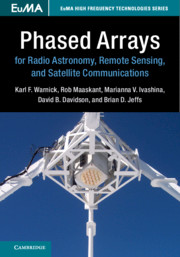Book contents
- Frontmatter
- Contents
- Preface
- Acknowledgements
- Notation and Units
- 1 Phased Arrays for High-sensitivity Receiver Applications
- 2 Active Antenna Receivers
- 3 Antenna Examples
- 4 Transmitting Arrays, Network Analysis, and Pattern Overlap Integrals
- 5 Array Receiver Theory and Modeling
- 6 Figures of Merit for Active Receiving Arrays
- 7 Design and Optimization of Phased Array Antennas
- 8 Numerical Modeling of Phased Array Antennas
- 9 Analog Front End, Array Elements, and Receiver Electronics
- 10 Array Signal Processing, Calibration, and Beamforming
- 11 Interferometric Arrays and Synthesis Imaging
- 12 Real Time Digital Signal Processing
- Index
- References
4 - Transmitting Arrays, Network Analysis, and Pattern Overlap Integrals
Published online by Cambridge University Press: 14 July 2018
- Frontmatter
- Contents
- Preface
- Acknowledgements
- Notation and Units
- 1 Phased Arrays for High-sensitivity Receiver Applications
- 2 Active Antenna Receivers
- 3 Antenna Examples
- 4 Transmitting Arrays, Network Analysis, and Pattern Overlap Integrals
- 5 Array Receiver Theory and Modeling
- 6 Figures of Merit for Active Receiving Arrays
- 7 Design and Optimization of Phased Array Antennas
- 8 Numerical Modeling of Phased Array Antennas
- 9 Analog Front End, Array Elements, and Receiver Electronics
- 10 Array Signal Processing, Calibration, and Beamforming
- 11 Interferometric Arrays and Synthesis Imaging
- 12 Real Time Digital Signal Processing
- Index
- References
Summary
The classical approach to array antenna analysis is to represent the field radiated by the array as a product of the radiation pattern of one element and an array factor that includes the locations and excitations of each element in the array. This approach has been used for many decades to design phased arrays for many applications, from radar and terrestrial communications to satellite systems and radio telescopes.
For high performance receiving arrays, the approximate factorization of the array radiation pattern into an element pattern and array factor may not be accurate enough to use when designing for stringent performance requirements. Mutual coupling causes element radiation patterns to differ across the array, and this must be taken into account in the design process from the beginning. For this reason, we will only briefly consider the classical array factor technique in this chapter, and move instead to a more sophisticated analysis method based on overlap integrals and network theory.
The array factor method certainly has enduring value. The array factor provides an intuitive way to analyze, understand, visualize, and design steered beams and array radiation pattern. It can be taught in a simple way to students of array theory, yet is useful in designing highly sophisticated multiantenna systems. Optimal designs, such as the Chebyshev array, can be readily treated within this framework.
For the high sensitivity applications of interest in this book, the array factor method is only useful for rough designs, and a more advanced approach is needed. The overlap integral and network theory approach comes at a price. It relies on numerical approximations or full wave simulations of embedded element patterns, and is not amenable to pencil and paper treatments. The analysis methodology used in this book is intended from the ground up to be used with numerical methods and optimization tools. As a middle ground between the array factor method and full wave numerical modeling, we will also develop the lossless, resonant, minimum scattering approximation.
The standard approach to antenna theory is to treat transmitting antennas first, followed by the receiving case. After reviewing the classical array factor method and other basic concepts of simple array antennas, we will develop the overlap integral and network theory first for a transmitting array.
Information
- Type
- Chapter
- Information
- Publisher: Cambridge University PressPrint publication year: 2018
References
Accessibility standard: Unknown
Why this information is here
This section outlines the accessibility features of this content - including support for screen readers, full keyboard navigation and high-contrast display options. This may not be relevant for you.Accessibility Information
- 1
- Cited by
